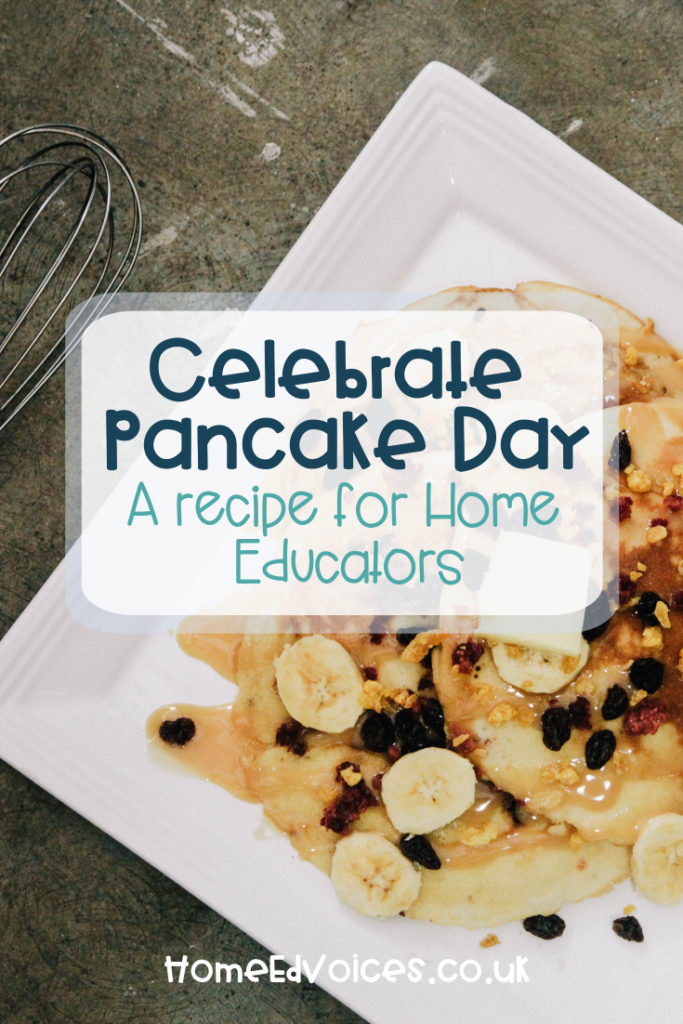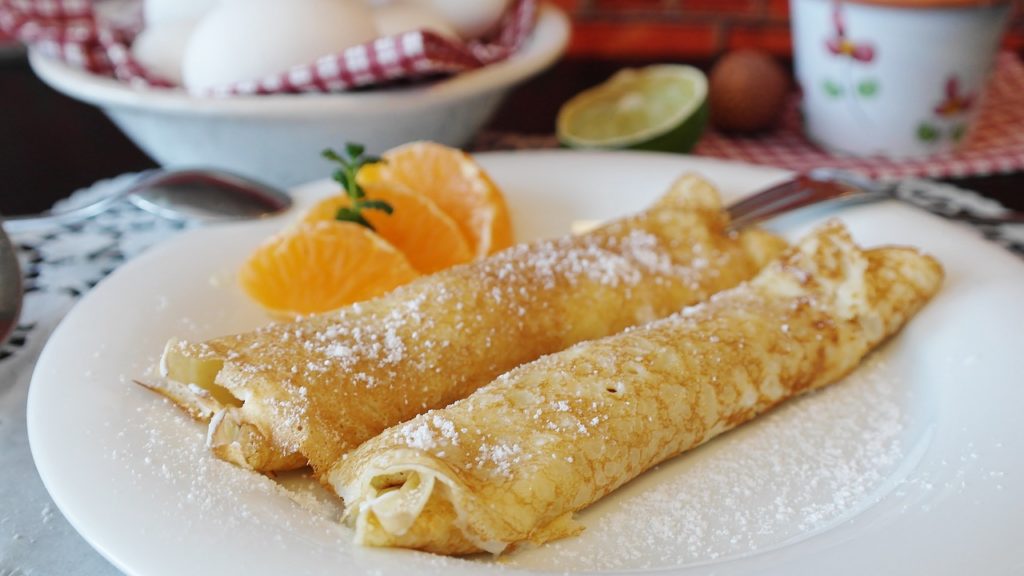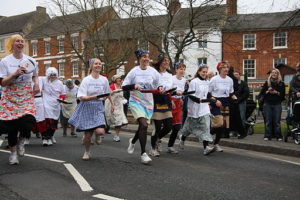Celebrate Pancake Day 2020

Pancake day is next Tuesday, February 25th, 2020. So, now’s the time to check out your recipe options and gather ingredients as well as print some resources if you wish. Then bookmark this post and return on the day.
I’m so excited for Pancake Day! As a kid growing up in America with a single-dad, pancakes for dinner are something we had often, but they still bring back the best sort of nostalgic memories, (though it would be unkind not to mention he also made fab steak and spaghetti dinners too). As a home educator of Britican (Americish?) children, I do so love to have this excuse to make pancakes for dinner and drop some knowledge at the dining table as we tuck in. So, in honour of my love for this British holiday, I have organised my random knowledge of Pancake Day trivia into some sort of a ‘study guide’ that should make for a fun day if you, like me, want to drop the routine learnin’ in favour of some quirky pancake celebratin’ for the day.
Language Arts
A poem to read aloud/ memorize/ recite (preferably while making pancakes!):

Mix a Pancake
by Christina Rosetti
Mix a pancake,
Stir a pancake,
Pop it in the pan;
Fry the pancake,
Toss the pancake—
Catch it if you can.
Maths
Weights and measures with cooking
Make pancakes of course! Cooking is the most fun way to learn about measurements whether you weigh your ingredients or scoop them with fraction cups. Start with a small recipe and multiply it or start with a large recipe and divide it for more of a challenge.
A couple of my favourite recipes:
Eva’s vegan crepes – UK-style from The Curious Chickpea. This recipe has both fraction measurements and weight measurements.
Cara’s gluten-free vegan pancakes – American-style from Fork and Beans (Watch out if you’re increasing the recipe with the widget as you’ll notice the amount of GF blend never changes and that’s not right!). This recipe uses fraction cups, but the ingredients are minimal if you have a GF blend, so you could rewrite the recipe with a conversion app.
Percentages with religions
If the world were a village of 100 people:
- 30 would be Christian
- 25 would be Muslim
- 15 would be Hindu
- 8 would be Buddhist
- 6 would follow a local religion
- 1 would account for all other religions
- 15 would say they follow no religion
- (based on percentages provided by Wikipedia February 2020)
Print the following picture and colour it in accordingly.

Science
Chemistry
Whether you make fluffy or crepey pancakes will determine which chemical reactions you can discuss as you cook pancakes.
Solids, Liquids, Solutions, Suspensions and Colloids
For both types you can discuss the mixing of solids and liquids. You can discuss how your batter is neither solid nor liquid once mixed, but a colloid. It isn’t a solution because the solids aren’t dissolved in the liquid. You can’t separate your ingredients again through evaporation. And it isn’t a suspension because you can’t wait for your solid ingredients to separate from your liquid ingredients by settling to the bottom. In a colloid, particles are evenly suspended throughout as in a suspension, but appear dissolved as in a solution because they will never settle out.
Atoms, Heat Conduction and Physical Changes

For both types of pancakes you can discuss how heat transfers from the hob to the pan to the pancake by atoms vibrating faster and bumping into slower atoms and causing those atoms to speed up. And as these atoms speed up, the water molecules in the colloid break off and evaporate, leaving behind only the solids of our colloid, which is still a colloid, just now it’s a solid colloid – a physical change.
Chemical Reactions
As the pancake heats up, there are also chemical reactions taking place inside the pancake. When the amino acids in the proteins in your batter heat up they chemically bond with the carbon and oxygen in the sugars. This chemical reaction is what causes the pancake to turn a golden colour and make that amazing smell.
If you’re making fluffy American-style pancakes, there is a further chemical reaction happening with the sodium bicarb. The sodium bicarb in your batter, when heated, releases carbon dioxide, bubbles of gas that get trapped in the batter as it turns solid, making for fluffy pancakes. But without an acid, sodium bicarb is only half as effective as it could be. This is why so many recipes for American-style pancakes call for buttermilk. You can make your own buttermilk by adding vinegar to milk. And I think we all know what happens when you add vinegar to sodium bicarb… volcanoes and super fluffy pancakes!
The Scientific Process, Experimentation and Variables
I find American-style pancakes the most fun for scientific experimentation. If you start with a basic recipe, you can divide your dry and wet ingredients in two. Mix half a batter and make up some pancakes. With the other half, you can add a bit of vinegar to your wet ingredients, mix up the other half of the batter and see how the pancakes differ. If you’re not vegan, you could even divide your wet and dry ingredients into threes and experiment with how eggs affect the fluffiness of your pancakes. But be sure you mix one experiment at time, because wet sodium bicarb will release gas as it sits and by the time your second or third batch of pancakes hits the frying pan the sodium bicarb will be less effective and the integrity of your experiment compromised.
History and RE
(feel free to read this aloud whilst tucking in)
Pancake Day is a variable holiday, meaning it’s not always on the same date and could fall in February or March. It’s always on the Tuesday that is 47 days before Easter, which is also a variable holiday. Easter is always on the first Sunday after the first full moon after the Spring Equinox.
We can eat pancakes any time we like, so why do we have a special day for making and eating pancakes that is determined by the moon?
Since the 1400’s, at least, Christians have celebrated Shrove Tuesday, Ash Wednesday, the season of Lent and then Easter, in that order. On Shrove Tuesday, Christians would ‘shrive’ or free themselves of the guilt of their sins at church in the morning. They would then use up all their extravagant ingredients in an afternoon of feasting before Ash Wednesday which signalled the beginning of Lent. Lent was a season of fasting that lasted until Easter when the Christians would feast again. Christians still honour this history of fasting by giving up something of value for the season of Lent.
Eggs and fat were some of the extravagant ingredients that were forbidden during the season of Lent. If you whisk your eggs and fat into a bowl with milk and flour you get…pancakes!

One story goes that a mother in Buckinghamshire was in the midst of cooking up her batch of pancakes for the afternoon feast when she heard the church bell for last confession. She ran for the church, frying pan in hand, flipping the pancake as she went to keep it from burning.
Another story goes that a stack of pancakes were gifted to the church bell ringer as a bribe to ring the bell early and begin the afternoon of celebration. Yep, pancake day used to be a half-day holiday in Britain!
And so, we eat pancakes on Shrove Tuesday and have dubbed the holiday Pancake Day. The church bell on Shrove Tuesday is also sometimes called the pancake bell. And all over Britain you can find pancake races and variations on the theme to take part in.
‘Pagan’ origins
Long before the 1400’s, people the world over explained the changing of the seasons as a battle between light and dark. People would make and eat hot round cakes, symbolizing the power, light and warmth of the sun, to help the god of Spring and life win his battle against the god of Winter and death.
The first pancake was left on the windowsill for the ancestors. The last pancake was burnt in a bonfire as a sacrifice to the gods.
Practical origins
It’s also likely that the tradition of making foodstuffs from animal products – eggs, milk, butter – mixed with a small amount of flour followed by a period of fasting has to do with Britain’s four seasons and what farmers call The Hungry Gap – when last year’s crop is finished and this year’s crop still isn’t fully grown – which lasts from April to June. A period of fasting in the lead up to April would have preserved some of the crops like root vegetables and dried grains for the upcoming hungry gap. But animals are less affected by the seasons than plants, so foods made largely from animal products, like pancakes, would be a likely choice of meals at this time.
Geography
Some version of Shrove Tuesday is practiced wherever Christians live. Unfortunately for them, they don’t all celebrate with pancakes.
If you would like to introduce or review some geography for Pancake Day, print a world map, or point at a poster if you prefer, and draw pancakes on all countries that celebrate Shrove Tuesday. For bonus points, find out how they celebrate Shrove Tuesday, if not with pancakes.
Countries that celebrate Shrove Tuesday:
- Australia
- Austria
- Belgium
- Brazil
- Canada
- Columbia
- Czech Republic
- Denmark
- Estonia
- Finland
- France
- Germany
- Italy
- Netherlands
- Norway
- Poland
- Portugal
- Russia
- Spain
- Sweden
- Switzerland
- United States of America
Crafts and Activities
For younger ones, Red Ted Art has an adorable fortune teller craft that’s full of Pancake Day facts, as well as a page of other crafts and activities for a fun-filled Pancake Day.